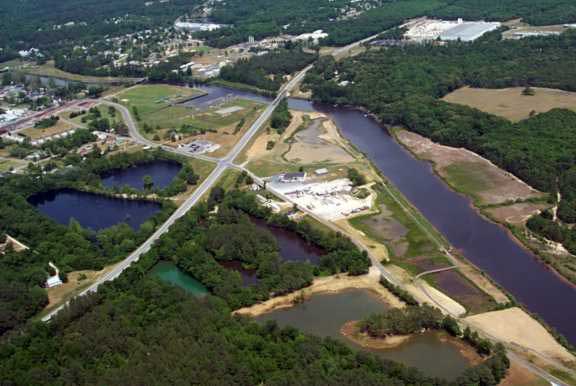Introduction
The Marshy Hope Creek Restoration Project began in 1995, sponsored by the Department of Natural Resources (once part of DNR and now the mitigation program of the MD Dept. of the Environment) and the Town of Federalsburg, in Caroline County. Others State and local agencies joined the restoration effort including the Chesapeake Bay Trust, Maryland State Highway Administration, and the Chesapeake Bay Foundation. The restoration project used Nontidal Wetlands Compensation Funds to create and restore riparian areas and wetlands in the floodplain of Marshy Hope Creek. The budget for this restoration project was approximately $125,000. The Maryland National Guard was utilized in the contruction phase of the restoration project which helped to reduce approximately 30% of the actual costs of the restoration. During the planning stages, the restoration project was expanded to include enhancements that provide recreational and educational benefits for visitors and the citizens of Federalsburg, including extension of an existing Greenway trail, fishing piers, bridges, and a boardwalk.
Purpose
- The purpose of the Marshy Hope Creek Riparian and Wetland Restoration Project was to:
- Restore and create vegetated tidal and nontidal wetlands in and adjacent to the floodplain
- Create additional flood retention areas
- Improve waterfowl habitat and riparian areas
- Provide recreational and educational opportunities for town residents and visitors
- Incorporate a trail system as a component of the local greenway corridor
Phase One
Phase One of the restoration project involved the excavation, grading and planting of two wetland "cells" to construct a combination of tidal and nontidal wetlands.

The photograph shows one of the constructed wetland "cells" (center) and the partially vegetated floodplain (left). [photo by Julie Labranche]
Phase Two
Phase Two of the restoration project involved construction and planting of a third wetland "cell" in the northern portion of the site and approximately five acres of wetlands around the perimeter of a privately owned pond.

The photograph shows the three constructed wetland "cells" and the surrounding riparian areas. [photo by Julie LaBranche]
Project Results
The restoration project produced a total of 12.34 acres of constructed wetlands including:
- 2.46 acres of palustrine forested wetlands
- 5.70 acres of palustrine scrub-schrub wetlands
- 4.18 acres of palustrine emergent and open-water wetlands

The photograph shows an overview of the entire wetland and floodplain restoration including constructed wetlands, riparian areas and vegetated floodplains as well as the constructed walkway (parallel to the Creek). [photo by Julie LaBranche]
With a new connection to to the tidal waters of Marshy Hope Creek, the restoration project created vital new habitat for native species including spawning areas for anadromous fish such as Blueback Herring, Striped Bass, American and Hickory Shad, and Alewife.
In addition, a nearby abandoned sand and gravel mine was partially filled with material removed from the floodplain, creating a new wetland. The trail system with interpretive displays provides educational and recreational opportunities for residents and visitors.